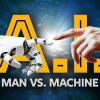
Breaking News
6.8 SPC vs. 300 Blackout: Powering Up the AR Platform
 Autism Study By McCullough Foundation Begins New Era of Free Scientific Inquiry
Autism Study By McCullough Foundation Begins New Era of Free Scientific Inquiry
 REVOLUTION DAY 8: Libertarians JOIN The Revolution
REVOLUTION DAY 8: Libertarians JOIN The Revolution
 US Government and Westinghouse $80bn Nuclear Reactor Deal
US Government and Westinghouse $80bn Nuclear Reactor Deal
Top Tech News
 Graphene Dream Becomes a Reality as Miracle Material Enters Production for Better Chips, Batteries
Graphene Dream Becomes a Reality as Miracle Material Enters Production for Better Chips, Batteries
 Virtual Fencing May Allow Thousands More Cattle to Be Ranched on Land Rather Than in Barns
Virtual Fencing May Allow Thousands More Cattle to Be Ranched on Land Rather Than in Barns
 Prominent Personalities Sign Letter Seeking Ban On 'Development Of Superintelligence'
Prominent Personalities Sign Letter Seeking Ban On 'Development Of Superintelligence'
 Why 'Mirror Life' Is Causing Some Genetic Scientists To Freak Out
Why 'Mirror Life' Is Causing Some Genetic Scientists To Freak Out
 Retina e-paper promises screens 'visually indistinguishable from reality'
Retina e-paper promises screens 'visually indistinguishable from reality'
 Scientists baffled as interstellar visitor appears to reverse thrust before vanishing behind the sun
Scientists baffled as interstellar visitor appears to reverse thrust before vanishing behind the sun
 Future of Satellite of Direct to Cellphone
Future of Satellite of Direct to Cellphone
 Amazon goes nuclear with new modular reactor plant
Amazon goes nuclear with new modular reactor plant
 China Is Making 800-Mile EV Batteries. Here's Why America Can't Have Them
China Is Making 800-Mile EV Batteries. Here's Why America Can't Have Them
SpaceX stacking giant Super Heavy rocket ahead of Starship orbital flight test (photo)

SpaceX is gearing up for the most ambitious test flight yet of its Starship Mars rocket.
Last month, a Starship prototype aced a high-altitude test flight for the first time, soaring about 6.2 miles (10 kilometers) into the skies above SpaceX's "Starbase" site in South Texas and then touching down safely back at the facility. (Four other Starship test vehicles had tried this uncrewed hop in the previous five months, but none of them managed to stick the landing.)
Even before achieving that milestone, however, SpaceX had started planning out the first Starship flight to Earth orbit. In March, for example, company founder and CEO Elon Musk tweeted that SpaceX was targeting July for that landmark trial, which will require both elements of the reusable Starship system — the 165-foot-tall upper-stage spaceship, called (somewhat confusingly) Starship, and the huge first-stage booster known as Super Heavy.
Super Heavy was not involved in the 6.2-mile-high flight; that May 5 jaunt employed just a prototype Starship upper stage, one outfitted with three of SpaceX's next-generation Raptor engines. (The final Starship spacecraft will sport six Raptors and Super Heavy about 30 of them, Musk has said.)
In mid-May, we learned the details of the coming orbital test, thanks to a document filed with the U.S. Federal Communications Commission (FCC) that was first reported by The Verge.

 China Innovates: Transforming Sand into Paper
China Innovates: Transforming Sand into Paper

